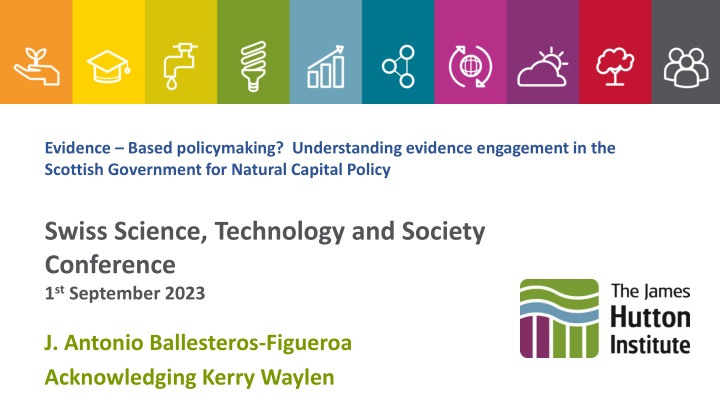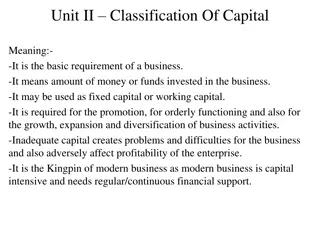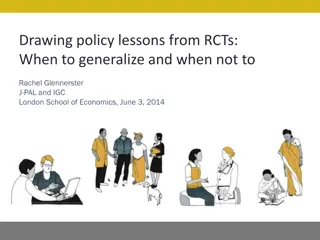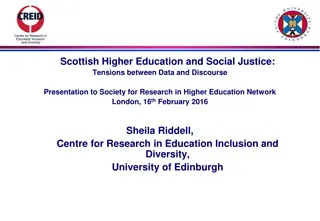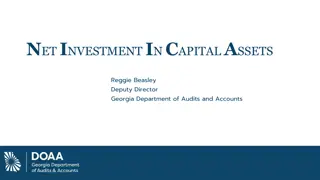Natural Capital Policy in Scottish Government: Evidence-Based Policymaking
This presentation explores how the Natural Capital approach influences decision-making for sustainable transitions in the Scottish Government. It delves into the role of Natural Capital in challenging or reinforcing the assetisation of the environment, aiming to understand its usage in policymaking processes.
Download Presentation

Please find below an Image/Link to download the presentation.
The content on the website is provided AS IS for your information and personal use only. It may not be sold, licensed, or shared on other websites without obtaining consent from the author.If you encounter any issues during the download, it is possible that the publisher has removed the file from their server.
You are allowed to download the files provided on this website for personal or commercial use, subject to the condition that they are used lawfully. All files are the property of their respective owners.
The content on the website is provided AS IS for your information and personal use only. It may not be sold, licensed, or shared on other websites without obtaining consent from the author.
E N D
Presentation Transcript
Evidence Based policymaking? Understanding evidence engagement in the Scottish Government for Natural Capital Policy Swiss Science, Technology and Society Conference 1stSeptember 2023 J. Antonio Ballesteros-Figueroa Acknowledging Kerry Waylen
Introduction This presentation seeks to discuss whether the Natural Capital approach reinforces or challenges the assetisation of the environment (Levidow, 2020). The research is part of a larger project being conducted at the James Hutton Institute in Aberdeen, Scotland. The Galvanizing Change via Natural Capital project seeks to understand how the concept of Natural Capital can influence decision making towards sustainable transitions.
The environment as a diversity of concerns Food, potable water, clothing, a roof over one's head, clean air, a sense of belonging, participating with others in one's community, and a reason for hope are no doubt universal needs. Nevertheless, the emphasis people place on the goods and services Nature supplies differs widely. To farmers in South Asia and Sub-Saharan Africa, it could be declining sources of water and increasing variability in rainfall in the foreground of global climate change. To indigenous populations in Amazonia, it may be eviction not just from their physical home, but from their spiritual home too. To inhabitants of shanty towns everywhere, the worry may be the infections they are exposed and subjected to from open sewers; to the suburban household in the UK, it may be the absence of bees and butterflies in the garden; ( ) The Economics of Biodiversity: The Dasgupta Review (Dasgupta 2021)
Aims Explore whether the notion of NC may be strengthening specific types of expertise, perhaps economic approach towards the environment. Understand what is the role of Natural Capital in challenging or reinforcing the assetisation of the environment? To lay the foundations for a study aiming to understand how the concept of Natural Capital may being used within the Scottish Government as part of the policy-making process.
Ecosystem Services and Environmental Policy-making One of the dispositifs through which climate change is expected to be managed is the notion of Ecosystem Services (ES). Ecosystems are defined based on their contributions to human well-being (Haines-Young and Potschin 2018). This approach recognises ecosystems as "valuable capital assets" to which it is necessary to set prices on the "services" they provide (Kareiva et al. 2011:4). ES can be seen as an expectation given the need to analyse who, and under which conditions, is designing these projects. ES operate under the assumption that the only way for humans to care about the environment is by valuating it in economic terms (Redford and Adams 2009). Therefore, ecosystem services are a proposed way to care for the environment by highlighting its economic value.This includes understanding ecosystems as "capital goods like produced capital (roads, buildings, ports, machines), with the difference that nature cannot always be regenerated after its collapse (Dasgupta 2021:52). ES is the immediate precedent of Natural Capital.
Natural Capital Natural Capital is the latest concept that aims to help raise the profile and commitment to nature in environmental decision-making, what could be called Sustainable Development. It is a concept associated with quantification and valuation but this isn t automatically or necessarily essential when discussing natural capital. Understanding natural capital could be aided by using particular datasets, and apps tools or portals designed to aid querying them in terms of natural capital, or decision-makers own perceptions of natural capital and its components. Some of these approaches can entail considerable investment of resources, either to collect data, develop new interfaces, or in time by the decision-makers themselves; so understanding what investments of effort are really worthwhile is quite important. Is a rhetorical device intended to help transform how well we manage our environment, especially by persuading new actors to support and resource this transformation. However, its potential to alienate and/or unhelpfully transform conceptions and practices relating to the environment mean its consequences cannot be assumed as positive (Levidow, 2020).
Key Characteristics of Natural Capital Valuation Sustainability Accounting Policy Development Economic Benefits Trade-offs Resilience
STS, Expertise and Governance through valuation Deborah Stone notes how the quantification of everything has triggered a "numbers versus stories" (Stone 2020 XII-XIII) issue, where facts (numbers) are expected to substitute experiences (stories). Alonso and Starr (1987) argue that statistics are the products of social, political and economic interests often in conflict. Fran ois Vatin (2013) distinguishes between valuation as evaluation [ valuer] and as valorisation [valoriser]. While the former refers to "assessment of value", the latter signifies "production of value". Valuation studies are particularly interested in studying valuation from a Marxist lens focused on the sociology of value creation.
Valuation and Natural Capital In the case of the environment, ecosystems are valued [valoriser] based on the assemblages between their constitutive elements, markets and other economic entities (Fredriksen 2017:49). An example of this is reforestation projects intended to operate as a carbon offsetting mechanism. Ehrenstein and Muniesa (2013) demonstrate how, given the time trees need to grow, the value of these projects is often based on imaginaries of the 'what might be . The value of trees is dependent on how much carbon they can sequestrate. By this, trees are observed through capitalist lenses within sociotechnical imaginaries of climate change. Rather than establishing a value ( valuer), market values will reinforce existing categorisation processes defined by dominant epistemic communities. Hence, market-based valuations are not the only performative processes that should be evaluated, but the entire ensemble through which these are done. Working with NC thus tends to assetisation (Levidow 2020).
Natural Capital and the Assetisation of Nature According to a report produced by Swiss RE, 55% of the global GDP depends on Biodiversity and Ecosystem Services (BES). For this company, it is essential to create insurance mechanisms that can protect the investments of those financially benefiting from BES. They argued that biodiversity is vital for drug discoveries worldwide, implicitly assuming that a decrease in biodiversity is terrible for the market; not for nature. Les Levidow (2020) coined the term of "assetisation" to refer to the current process in which nature is seen as the property of the private sector. Assetisation thus seeks to detach all non-economic value from nature as a way to incorporate social relationships to nature within a corporate logic.
How is/could NC be integrated in policy- making Nature is not only not uniform, and the replicability of scientific processes is anything but easy (Porter 1995:13). Civil servants engaging in Natural Capital will seek to strip as many singularities from nature as possible as a way of making its valuation possible. Underlying the introduction of the NC concept - as with ES there is an implicit assumption that new data and/or new tools to present data will help to tackle sustainability challenges. However, truly embracing the implications of post-modernity, of complexity and uncertainty, is politically and societally unpalatable and inconvenient (Strand, 2002). By contrast, some (especially those who have traditionally identified with environmentalism) fear that natural capital will inevitably worsen how society relates to and treats nature (Levidow, 2020), related to the debates over the marketisation of conservation (Spash, 2022).
Initial insights Our conceptual analysis allows us to start designing research questions towards the use of NC approaches by civil servants. We need to attend to pre-existing rationalities & processes How do these combine with NC approaches What do they mean for how nature is being valued [ valuer or valoriser?] What is being left out in this process and why? What are the consequences for policy development?
This research has been funded by: Acknowledgements This project is funded as part of the Scottish Government 2022-2027 Strategic Research Programme (project JHI-D5-3) - it does not necessarily represent the views of the funder. www.hutton.ac.uk/research/projects/galvanising-change-natural-capital
